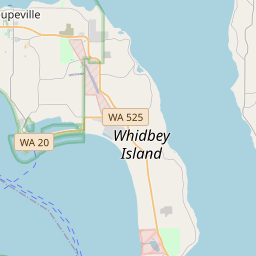Mary Barrett
Historical marker location:
162 Cemetery Road, Coupeville, Washington
( Marker is on Cemetery Road.)







© OpenStreetMap contributors
The Seattle Space Needle, built for the 1962 World's Fair, was designed to withstand winds of up to 200 miles per hour and earthquakes of up to 9.0 magnitude.
About Island County
Island County Timeline
Island County is located in the northwestern part of Washington state and is made up of two main islands, Whidbey Island and Camano Island, as well as several smaller islands. The area has a rich history dating back thousands of years. The earliest known inhabitants were indigenous tribes, such as the Skagit and Snohomish tribes, who relied on the abundant natural resources of the region for their livelihood.
In the late 18th century, the area was explored by European fur traders and explorers. The first recorded European to visit the islands was Captain George Vancouver in 1792. Subsequently, the area became an important trading post for both British and American ships that were involved in the lucrative fur trade.
In the mid-19th century, the islands began to be settled by non-native settlers. The Donation Land Claim Act of 1850 and the Homestead Act of 1862 encouraged settlers to move to the islands by offering them free land. Whidbey Island became home to farmers, loggers, and fishermen, with towns such as Coupeville and Oak Harbor developing as trade and transportation centers.
During World War II, Island County played a significant role as it was the location of several military installations, including the Naval Air Station Whidbey Island and the Fort Casey and Fort Ebey coastal defense batteries. These installations brought a large number of military personnel and their families to the area and had a lasting impact on the local economy.
Today, Island County has a diverse economy that relies on a variety of industries, including agriculture, tourism, military, and technology. The area is known for its picturesque landscapes, charming small towns, and outdoor recreational opportunities, attracting visitors from near and far. The history of Island County is celebrated and preserved through museums, historical sites, and annual events that honor the region's past.
In the late 18th century, the area was explored by European fur traders and explorers. The first recorded European to visit the islands was Captain George Vancouver in 1792. Subsequently, the area became an important trading post for both British and American ships that were involved in the lucrative fur trade.
In the mid-19th century, the islands began to be settled by non-native settlers. The Donation Land Claim Act of 1850 and the Homestead Act of 1862 encouraged settlers to move to the islands by offering them free land. Whidbey Island became home to farmers, loggers, and fishermen, with towns such as Coupeville and Oak Harbor developing as trade and transportation centers.
During World War II, Island County played a significant role as it was the location of several military installations, including the Naval Air Station Whidbey Island and the Fort Casey and Fort Ebey coastal defense batteries. These installations brought a large number of military personnel and their families to the area and had a lasting impact on the local economy.
Today, Island County has a diverse economy that relies on a variety of industries, including agriculture, tourism, military, and technology. The area is known for its picturesque landscapes, charming small towns, and outdoor recreational opportunities, attracting visitors from near and far. The history of Island County is celebrated and preserved through museums, historical sites, and annual events that honor the region's past.
Island County Timeline
This timeline provides a concise overview of the key events in the history of Island County, Washington.
- 1840s - The land that would become Island County is initially explored by European settlers.
- 1853 - Island County is established on December 22 as one of the original counties of the Washington Territory.
- 1873 - Coupeville is chosen as the county seat.
- 1883 - The Great Northern Railway extends its tracks to the county, boosting transportation and economic opportunities.
- 1909 - Deception Pass Bridge is constructed, connecting Whidbey Island to Fidalgo Island.
- 1940s - Naval Air Station Whidbey Island is established, bringing military presence and economic growth to the county.
- 1994 - The Admiralty Head Lighthouse in Ebey's Landing National Historical Reserve is restored and opened to the public.
- 2000s - Island County experiences population growth and increased development, particularly in the southern part of the county.